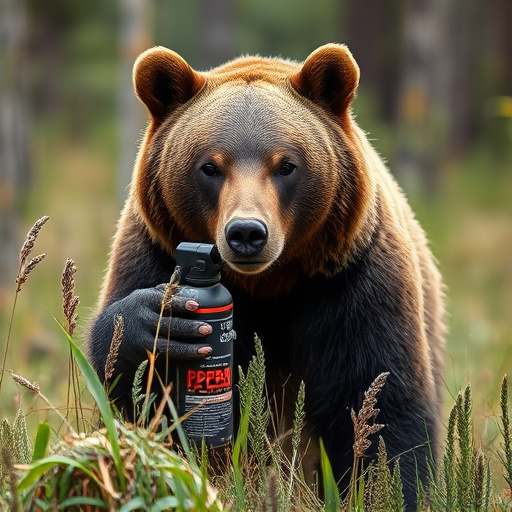Understanding the optimal range (20-100 feet) for bear spray use is crucial for outdoor safety. Effectiveness depends on repellent type, environmental conditions like wind, and aiming technique. Close ranges (up to 20 ft) require direct face spraying, while mid-distances (20-100 ft) need upward aim for maximum coverage. Always follow safety guidelines and product instructions for effective protection in bear country.
“Alaska’s rugged terrain presents unique challenges when it comes to bear safety. This comprehensive guide explores the maximum range of bear repellents, offering insights into their effectiveness and safety measures. We’ll analyze factors that influence spray distance, ensuring you’re equipped with knowledge for responsible outdoor exploration.
From understanding spray effectiveness to best practices at various distances, this article covers everything you need to know about the proper use of bear spray in Alaska’s diverse landscapes.”
- Understanding Bear Spray Effectiveness and Safety
- Determining the Maximum Effective Range of Bear Repellents
- Factors Influencing Bear Spray Range: A Detailed Analysis
- Best Practices for Safe and Effective Use at Different Distances
Understanding Bear Spray Effectiveness and Safety
Understanding Bear Spray Effectiveness and Safety
Bear spray, also known as grizzly repellent, is a popular choice among outdoor enthusiasts for personal protection against bears. However, it’s crucial to grasp the dynamics of its effectiveness and safety at various distances. The proper distance for bear spray use varies depending on factors like the bear’s behavior, terrain, and weather conditions. At close ranges, bear spray can be highly effective, creating a protective barrier that discourages aggressive behavior. But as you move further away, the spray’s reach and impact diminish significantly.
Knowing the maximum range of your bear repellent is essential. Typically, bear sprays are designed to be used within a 30-foot (or approximately 10 meter) radius for optimal effectiveness. Beyond this distance, the spray may not reach the bear, and its ingredients might not have the desired effect. It’s also important to remember that wind conditions can affect the spray’s trajectory and range. Therefore, always follow safety guidelines, use the repellent correctly, and be aware of your surroundings when venturing into bear country.
Determining the Maximum Effective Range of Bear Repellents
Determining the maximum effective range of bear repellents, such as bear spray, is crucial for ensuring safety in encounters with these powerful animals. The proper distance for bear spray use varies based on several factors, including the type of repellent, environmental conditions, and the specific bear species.
Generally, bear sprays are most effective when used at close to medium ranges—typically between 20 to 100 feet (6 to 30 meters). Beyond this range, the spray’s irritant components may not reach the bear effectively, reducing its deterrent effect. It’s important to remember that different repellents have varying maximum ranges, so checking product labels is essential. Additionally, factors like wind direction and speed can significantly impact the spray’s reach, with winds blowing towards you potentially minimizing the effective range.
Factors Influencing Bear Spray Range: A Detailed Analysis
The effectiveness and range of bear repellent spray, like Alaska’s Guard, are influenced by several environmental factors. The recommended proper distance for bear spray use varies widely depending on terrain, weather conditions, and the specific type of spray used. In open areas with calm wind conditions, the effective range can extend to 30 feet or more. However, in dense forests where the air is still and humid, the spray’s reach may be significantly reduced due to the mists that form after spraying.
Wind plays a crucial role; a gusty wind can quickly carry the spray away from its target, rendering it less effective. Conversely, a calm, still breeze allows the chemicals in the spray to linger longer, increasing the likelihood of bear deterrence. Additionally, the angle at which the spray is directed affects its range and penetration. Aiming directly at the bear’s face offers maximum protection within the stated range, while spraying at an angle may reduce both coverage area and effectiveness.
Best Practices for Safe and Effective Use at Different Distances
When using bear repellent, understanding and adhering to the proper distance is paramount for safety and effectiveness. At close ranges, typically up to 20 feet (6 meters), bear spray can be highly effective when applied directly to the bear’s face and eyes. This close proximity allows for optimal coverage, ensuring the bear receives a direct hit. However, it’s important to note that in such close quarters, accuracy is crucial; misting in the wind or at an angle may reduce the spray’s effectiveness.
For distances ranging from 20 to 100 feet (6 to 30 meters), users should aim for the bear’s face and body, aiming slightly upward to account for the spray’s range. This distance offers a balance between quick deployment and ensuring the spray reaches the bear effectively. Maintaining this proper distance for bear spray use significantly increases your safety during encounters while hiking or camping in bear country.
Understanding the maximum range of bear repellent, like Guard Alaska bear spray, is crucial for safe outdoor activities in bear country. While the manufacturer’s claims vary, research indicates that effective spraying should occur within a 30-foot (9 meter) range for black bears and grizzly bears. However, factors such as wind, terrain, and spray technique can significantly impact this distance. Always remember the proper distance for bear spray use—around you, not behind you—and follow best practices at different distances to ensure safety and effectiveness.
